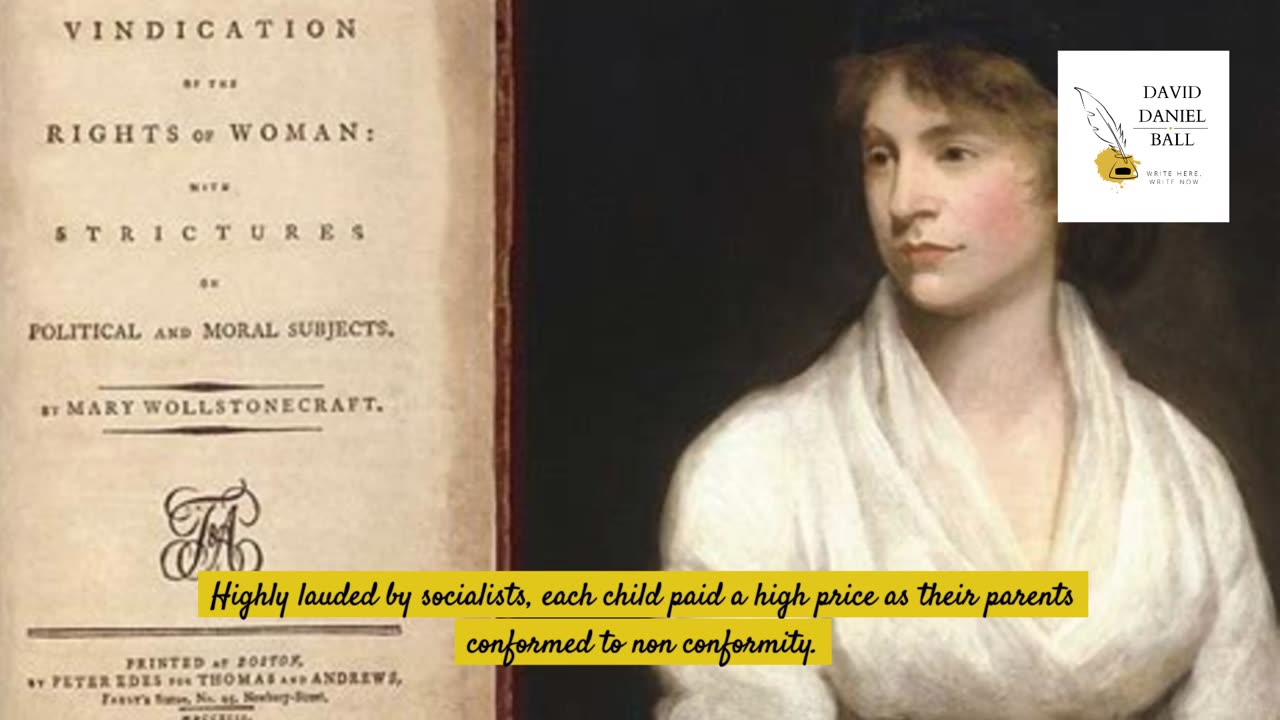Premium Only Content

The sad lives of Mary Wollstonecraft's daughters
I wrote this as an exercise to re evaluate what many now assume
Grok has it that ‘Mary Wollstonecraft was a British writer, philosopher, and one of the earliest advocates for women's rights, born on April 27, 1759, in Spitalfields, London. She is best known for her work "A Vindication of the Rights of Woman" (1792), where she argued for the education and equality of women, asserting that women are not naturally inferior to men but only appear so due to a lack of education.
However, that description is misleading in several aspects. Her work on the 'Rights of Woman' is now recognized as arguing for education and equality, but it was written to contradict Talleyrand’s report to the French National Assembly (1791), in which he asserted that women did not need education. Her book was a sequel to "A Vindication of the Rights of Men" (1790), which itself was a response to Edmund Burke’s "Reflections on the Revolution in France." Burke had written that the revolution was not similar to Britain’s glorious revolution but rather akin to Britain's civil war. Burke viewed it as an overthrow of a legitimate government that would result in more bloodshed, seeing it as anarchy that uprooted long-standing customs.
Mary’s work was not recognized in her lifetime. It became a 'cause célèbre' after Europe embroiled itself in socialism with the 1848 rebellions, none of which succeeded.
Early Life:
• Born into a family that experienced financial instability due to her father's speculative ventures, Mary grew up in an environment marked by domestic abuse and frequent moves.
• Despite limited formal education, she self-educated and worked in various roles, such as a governess, teacher, and lady's companion, which shaped her views on education and gender roles.
Romantic and Personal Life:
• Henry Fuseli: One of her notable but platonic relationships was with the Swiss painter Henry Fuseli. Wollstonecraft proposed a ménage à trois with Fuseli and his wife, which was rejected, leading to their estrangement. This episode reflects her unconventional approach to relationships, though it was more an intellectual and emotional bond than a romantic one.
• Gilbert Imlay: In 1792, while in France during the Revolution, Wollstonecraft met Gilbert Imlay, an American businessman. They had a passionate love affair, and she bore him a daughter, Fanny Imlay, in 1794. Their relationship was tumultuous; Imlay was not faithful, and Wollstonecraft experienced deep despair when he left her in 1795, even attempting suicide twice. Her experiences with Imlay are chronicled in her travelogue "Letters Written During a Short Residence in Sweden, Norway, and Denmark." As Joni Mitchell would later sing “We don’t need a piece of paper from the City Hall, keeping us tight and true.”
• William Godwin: After her heartbreak with Imlay, Wollstonecraft found solace and love with the radical philosopher William Godwin. Initially, they both adhered to principles against marriage, but they eventually married in 1797 when she became pregnant. Their marriage was brief but happy; Wollstonecraft died of complications from childbirth on September 10, 1797, eleven days after giving birth to their daughter, Mary Godwin, who later became Mary Shelley, the author of "Frankenstein." Godwin published a memoir after her death, which inadvertently tarnished her reputation due to its honesty about her unconventional life choices.
Mary Wollstonecraft's life was marked by her intellectual pursuits, her advocacy for women's rights, and her personal relationships, which were often at odds with the conventional societal norms of her time. Her works and life continue to be studied for their contributions to feminist philosophy and literature. However, her personal life often overshadowed her intellectual contributions in the public eye until the feminist movement of the 20th century brought renewed focus on her writings.
Mary’s tawdry carry-ons have been highly lauded from the late twentieth century. She did not write for posterity. She wrote to be in with the crowd. She supported the worst excesses of the French Revolution, because that was low hanging fruit to oppose orthodoxy. Her marriage did not protect her children, as later became apparent.
William Godwin (1756 - 1836) was a prominent British philosopher, political theorist, novelist, and journalist, known for his advocacy of political justice, rationalism, and anarchism. His most famous work, "Enquiry Concerning Political Justice" (1793), argued for a society based on reason and justice, where government would be minimal or non-existent as people would govern themselves through mutual agreement. The supposed Libertarian virtue here is overstated. Godwin the anarchist and non-conformist, only supported reason as it opposed sound governance. Others, like Karl Marx, would laud him for this.
Life and Philosophy:
• Born into a family with Nonconformist religious views, Godwin was a self-taught scholar who became deeply involved in radical politics and philosophy.
• He was a leading figure in the British Enlightenment, advocating for educational reform, the abolition of private property, and the establishment of a society where individual liberty would thrive.
Marriage to Mary Wollstonecraft:
• In 1797, Godwin married Mary Wollstonecraft, a significant figure in early feminism, despite his earlier objections to marriage as an institution. Their union was based on love and mutual respect for each other's intellect. Or, more aptly, convenience, and opportunism.
Children:
1. Fanny Imlay (1794 - 1816):
o Born to Mary Wollstonecraft from her relationship with Gilbert Imlay before she married Godwin. Godwin adopted Fanny and treated her as his own daughter. Tragically, Fanny committed suicide in 1816, overwhelmed by personal and familial challenges.
2. Mary Godwin (later Mary Shelley) (1797 - 1851):
o The daughter of Mary Wollstonecraft and William Godwin, Mary is renowned for writing "Frankenstein" or "The Modern Prometheus" at the age of 19. She married Percy Bysshe Shelley, a prominent Romantic poet. Their relationship and literary circle were influential in the Romantic movement. Mary Shelley had a complex relationship with her father, marked by both closeness and estrangement, particularly after her elopement with Shelley.
3. William Godwin Jr. (1803 - 1832):
o Born after Mary Wollstonecraft's death, to Godwin and his second wife, Mary Jane Clairmont. Less is documented about him, but he was involved in the literary world, notably in publishing and book-selling, following in his father's footsteps to some extent. He died at a relatively young age.
William Godwin's approach to parenting was somewhat unconventional for his time, influenced by his philosophical beliefs in autonomy and reason. He encouraged intellectual pursuits and critical thinking in his children, although the emotional complexities of his family life, marked by loss and remarriage, shaped their lives in profound ways. His influence on his children, particularly Mary Shelley, contributed significantly to their intellectual and literary legacies. William valued his bookstore as it forced wealthy people like Byron and Shelley to buy from him. He used his daughters to attract money. They reacted badly to this. Forced to carry the burden, Fanny committed suicide. She had been too you, on meeting Byron and Shelley, to do all her father wished.
Mary Jane Clairmont, born as Mary Jane Vial, was the second wife of William Godwin and stepmother to Mary Shelley. She had two children from previous relationships before marrying Godwin:
1. Charles Gaulis Clairmont (1795 - 1850):
o Born in Bristol, Charles was initially believed to be the son of Charles Abram Marc Gaulis, a Swiss merchant. However, the true identity of his father remains uncertain due to Mary Jane's complex personal history and the social norms of the time regarding illegitimacy.
o Charles studied in Switzerland and later moved to Vienna, where he became a professor of English literature at the University of Vienna. He was known for his scholarly work and had connections with European nobility. Charles died in Vienna in 1850.
2. Clara Mary Jane Clairmont (1798 - 1879), commonly known as Claire Clairmont:
o Claire was born in Brislington, near Bristol, and was initially called Jane but later adopted the name Claire. Her paternity was long a mystery; it was later discovered in 2010 that her father was Sir John Lethbridge, a Somerset landowner, although her mother had claimed her father was "Charles Clairmont."
o Claire is most remembered for her association with the Romantic poets Percy Bysshe Shelley and Lord Byron. She was the stepsister of Mary Shelley, with whom she shared a complex relationship. Claire had an affair with Lord Byron, resulting in the birth of her daughter, Allegra, in 1817. Allegra died at the age of five in a convent in Italy.
o After the death of Shelley and the end of her affair with Byron, Claire led a varied life as a governess, companion, and music teacher in various European cities like Vienna, Russia, Dresden, and Paris. She cared for her mother in her later years and converted to Catholicism in her old age. Claire outlived most of her contemporaries, dying in Florence in 1879.
Mary Jane Clairmont's children were thus brought up in a household rich with intellectual activity but also fraught with personal and financial difficulties. Their lives were deeply intertwined with the Romantic literary circle, influencing and being influenced by the cultural and philosophical counter movements of their time. Highly lauded by socialists, each child paid a high price as their parents conformed to non conformity.
-
 5:01
5:01
Faith and Philosphy
17 days agoBeethovens Magnum Opus
212 -
 12:19
12:19
Tundra Tactical
3 hours agoDaniel Penny Beats Charges in NYC Subway Killing
1131 -
 29:53
29:53
MYLUNCHBREAK CHANNEL PAGE
1 day agoUnder The Necropolis - Pt 1
55.2K20 -
 2:00:10
2:00:10
Bare Knuckle Fighting Championship
3 days agoCountdown to BKFC on DAZN HOLLYWOOD & FREE LIVE FIGHTS!
23.5K2 -
 2:53:01
2:53:01
Jewels Jones Live ®
1 day agoA MAGA-NIFICENT YEAR | A Political Rendezvous - Ep. 103
33.5K14 -
 29:54
29:54
Michael Franzese
7 hours agoCan Trump accomplish everything he promised? Piers Morgan Article Breakdown
56.3K43 -
 2:08:19
2:08:19
Tactical Advisor
11 hours agoThe Vault Room Podcast 006 | Farwell 2024 New Plans for 2025
142K11 -
 34:12
34:12
inspirePlay
1 day ago $4.45 earned🏆 The Grid Championship 2024 – Cass Meyer vs. Kelly Rudney | Epic Battle for Long Drive Glory!
53.1K8 -
 17:50
17:50
BlackDiamondGunsandGear
8 hours ago $0.96 earnedTeach Me How to Build an AR-15
31K3 -
 9:11
9:11
Space Ice
23 hours agoFatman - Greatest Santa Claus Fighting Hitmen Movie Of Mel Gibson's Career - Best Movie Ever
94.5K42